
Mauritia flexuosa
This palm species, known throughout Peru as aguaje, is dominant across large areas of wetland in the Peruvian Amazon. Mauritia palms thrive in the low-nutrient, water-logged ground of peatlands, conditions which many other species cannot tolerate. Under swampy, waterlogged conditions, any organic matter that arrives in the soil from the forest above decomposes only very slowly, and the roots, stems, branches and leaves of Mauritia contribute to the slow build-up of the organic-rich soils known as peat.
Photo: Anna Macphie
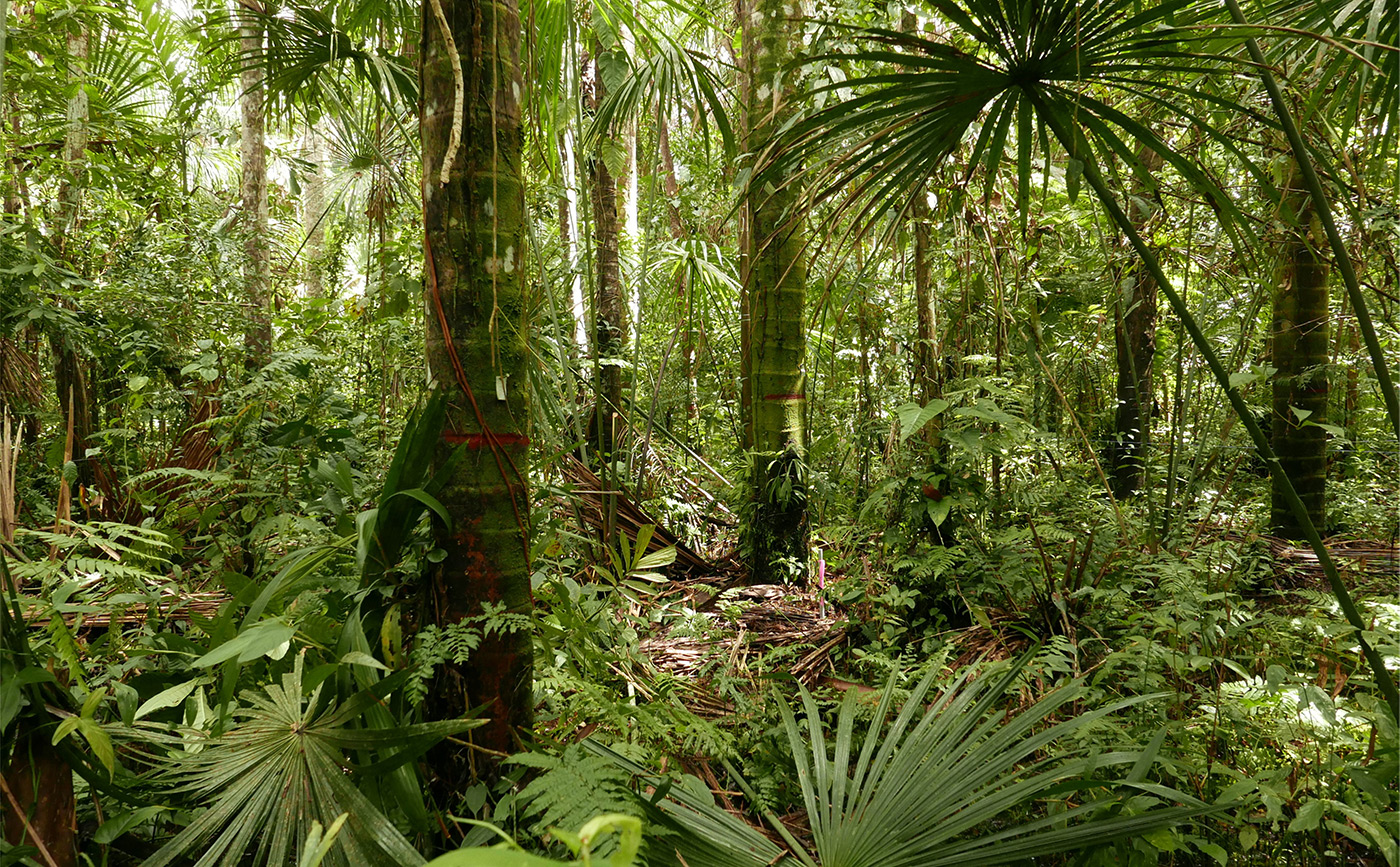
Peatland palm swamp (aguajal)
Sprays of leaves from young Mauritia flexuosa palms are visible in the foreground, while mature trunks (with horizontal marks) stretch into the distance. Mauritia dominate this type of peatland forest, the most widespread ecosystem in the Pastaza-Marañón basin. This is one of our study plots, and every stem greater than 10 cm in diameter has been tagged, identified and measured. Measurements are repeated regularly by ecologists to monitor stem growth, recruitment and mortality. Plant diversity in these plots is relatively low, averaging 38 species per 500 stems compared with 166 species per 500 stems in nearby unflooded rainforest.
Photo: Ian Lawson
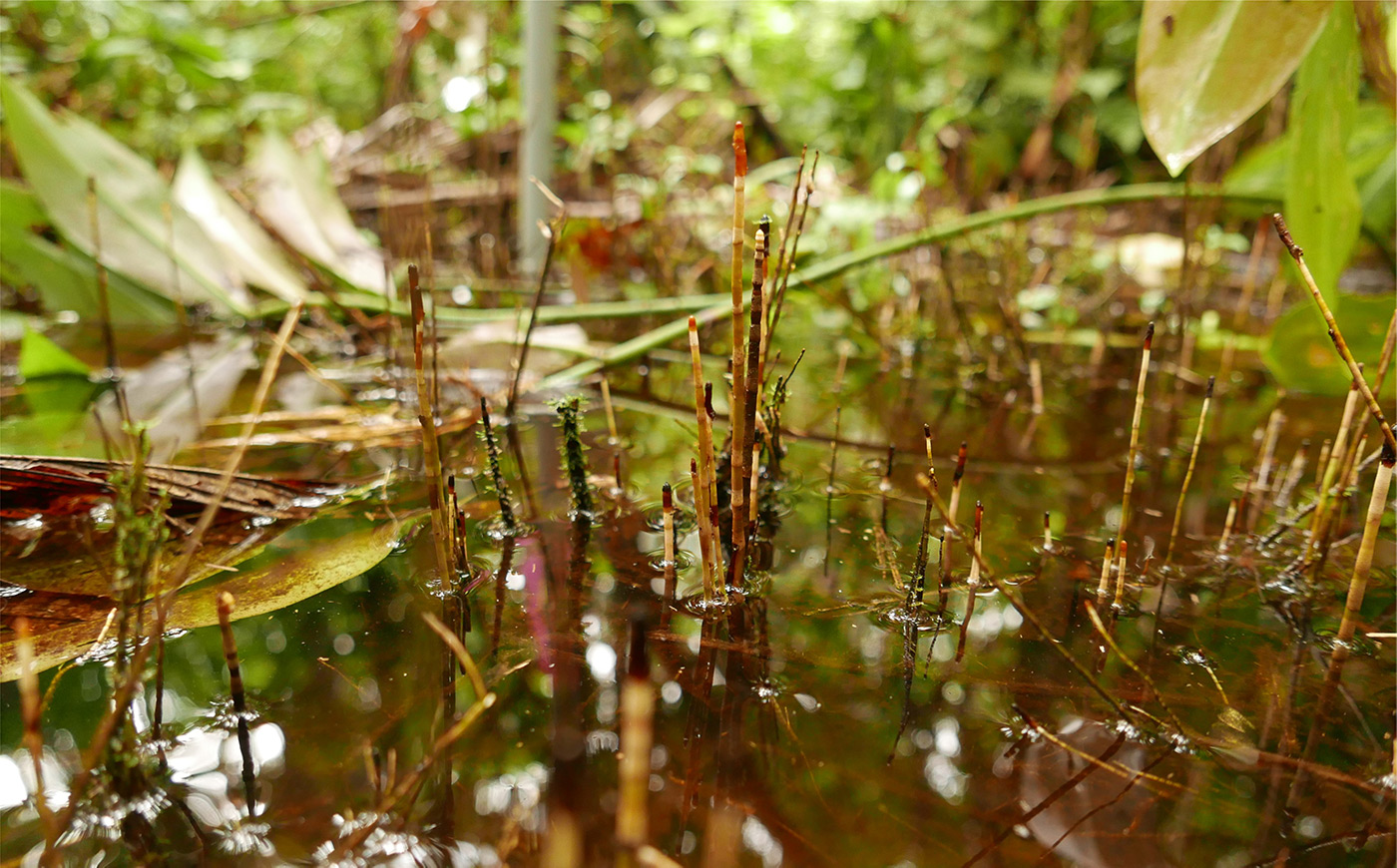
Breather roots of Mauritia flexuosa
Aerial breather roots (pneumatophores) rise above the surface of standing water in this close-up of the forest floor of a flooded palm swamp. These specialised roots are extensions of the palm’s underground root system, growing vertically upwards to reach above the water level like snorkels. They allow plants like Mauritia to grow in soil that is water-logged or even fully submerged for much of the year. Gas exchange (oxygen in, carbon dioxide out) takes place between the root tips and the atmosphere, allowing the roots to respire and the trees to thrive.
Photo: Ian Lawson
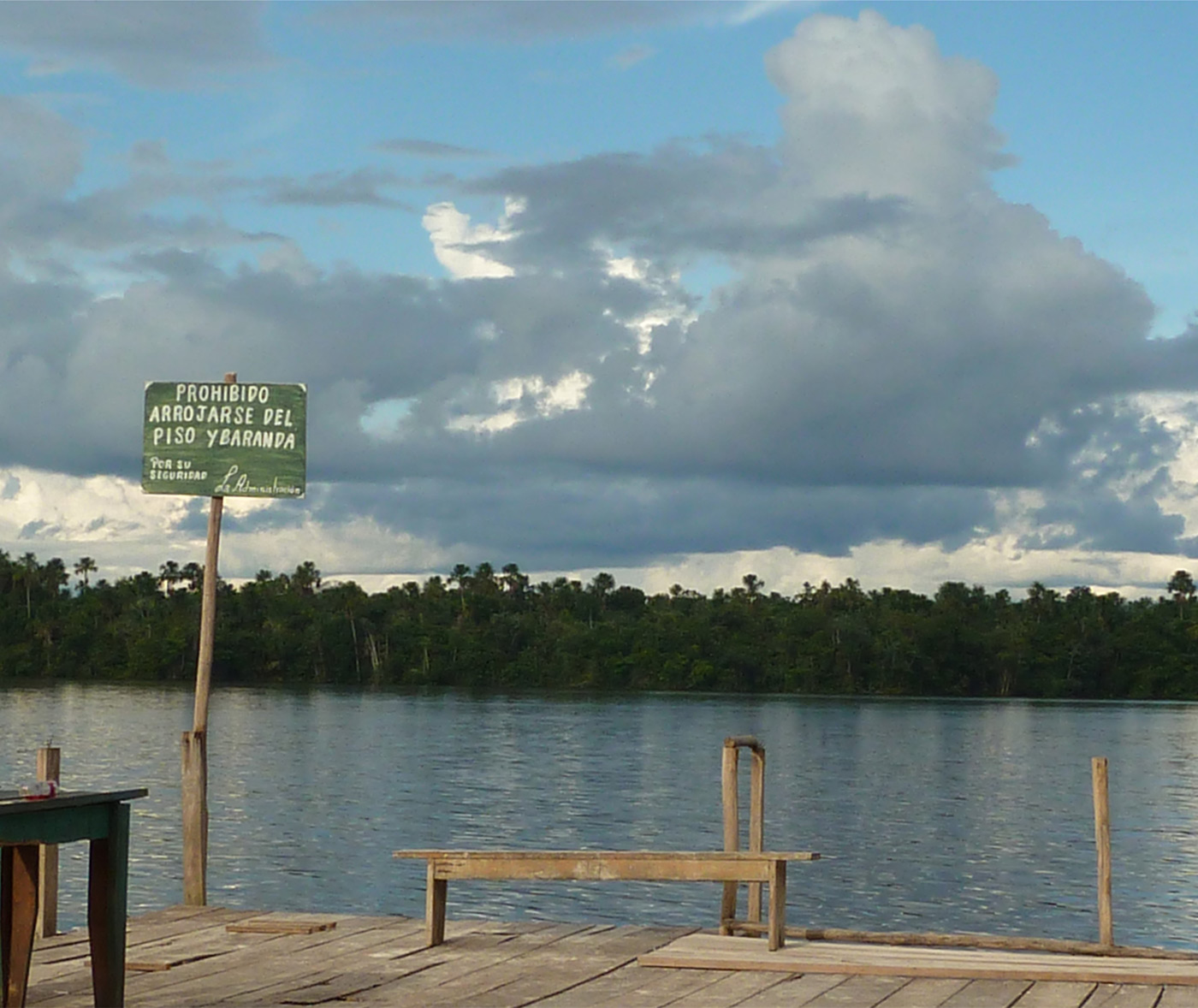
Quistococha Lake
Surrounded by peatland palm swamp, Quistococha is a large body of water 10 km from the city of Iquitos. Many peatlands around the world begin life as a lake; by studying Quistococha we can understand how these important environments form over thousands of years.
In the Amazon basin, rivers meander through the landscape in great looping curves, changing course and leaving behind abandoned channels and stranded lakes. Sediment cores from Quistococha contain sandy river sediment 5m below the lake bed, showing that it was part of a river channel until around 2,500 years ago. Finer sediments record when this part of the river channel was cut off, forming the lake, and fossil pollen in these sediments reveal that Quistococha’s fringing palm swamp began to form 1,000 years ago.
Photo: Katy Roucoux

Open peatland
Scattered Mauritia flexuosa palms in an open peatland close to the community of Veinte de Enero. Fossil pollen preserved in the peat shows that the vegetation at this site has been open — largely made up of sedges, grasses and ferns — ever since peat started to accumulate around 1,200 years ago. The scattered palms seen here are therefore colonising the open peatland, rather than being the last survivors of a once luxuriant forest.
Photo: Lydia Cole
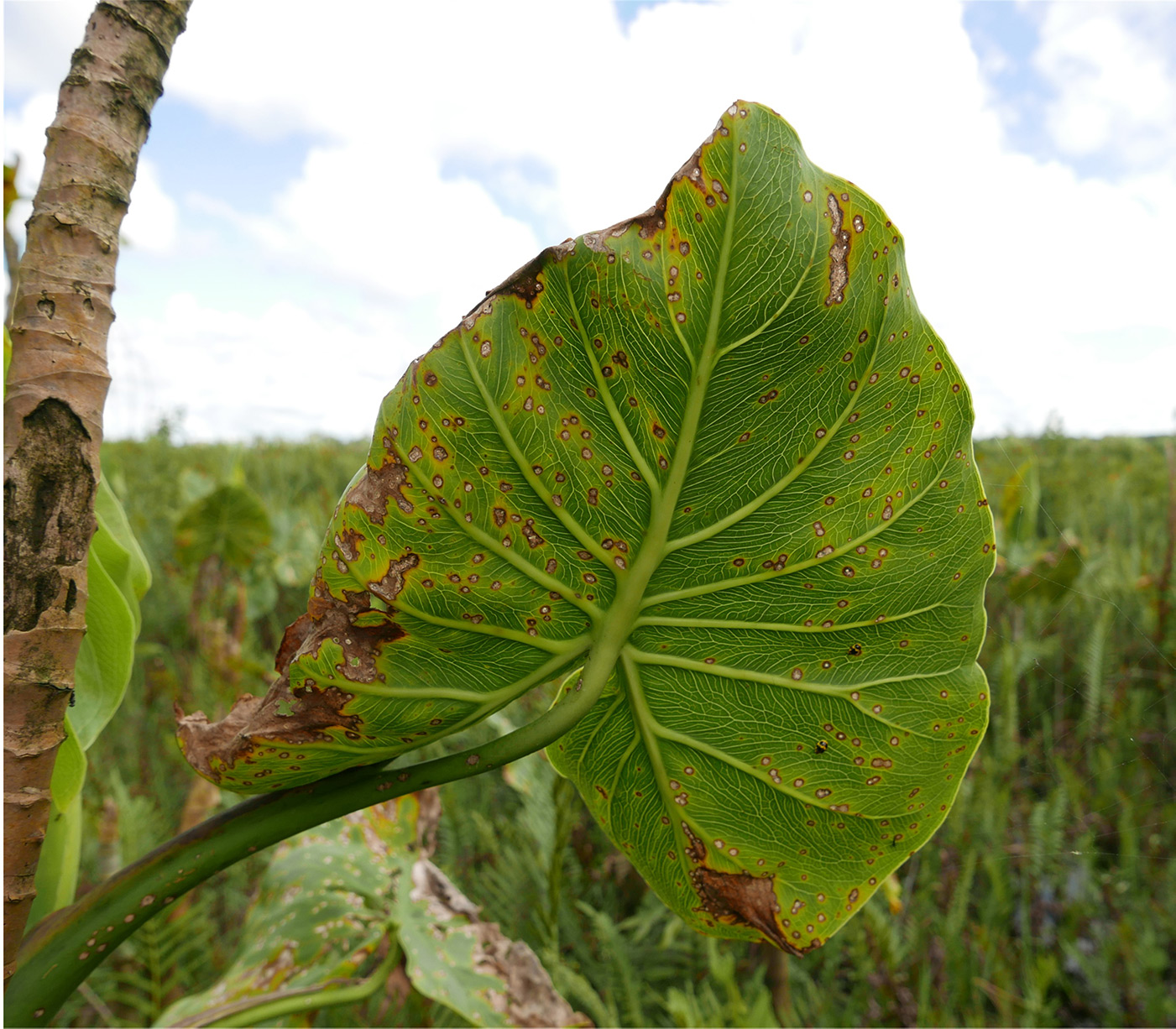
Montrichardia arborescens in an open peatland
The characteristic arrow-shaped leaf of Montrichardia arborescens, a member of the Arum lily family, is seen here against a background of ferns, grasses, sedges, and other semi-aquatic plants typical of open peatlands.
Montrichardia is a sun-loving, pioneer plant known throughout tropical South America, which often forms single-species clumps along river margins. It is a plant with multiple uses including the treatment of health conditions (including malaria, nose bleeds, abscesses, tumours, and ulcers), as animal feed, and as a lining for the bottom of dug-out canoes.
Photo: Ian Lawson

Cecropia, the forest pioneer
The palmate leaves of a Cecropia tree make a distinctive pattern against the sky through a gap in the peatland forest canopy. The genus Cecropia includes several tree species that are ecological pioneers, meaning that they grow quickly in response to a sudden influx of light through the space left by a fallen tree. Birch fills a similar ecological niche in Scotland.
Photo: Katy Roucoux
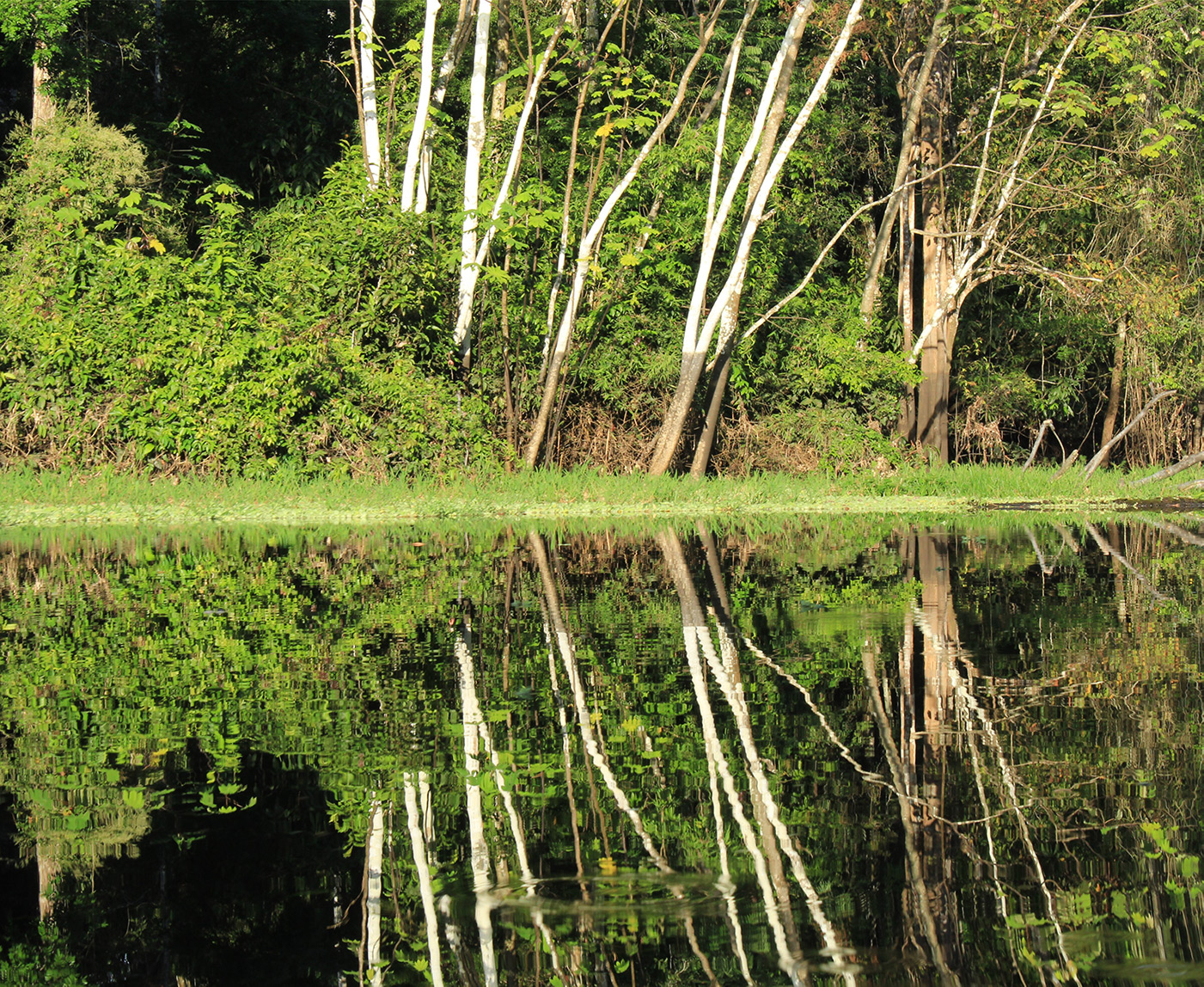
River bank
White stems of Cecropia are reflected in the mirror-like surface of the slow-flowing water. As ecological pioneers, the fast-growing Cecropia species thrive in the light at the edge of the forest and along unstable riverbanks.
Many species of Cecropia can tolerate with ease the deep floods which come each rainy season to this part of the Amazon. The sharp colour change, from brown to bright white, on each Cecropia trunk marks the height of last season’s flood.
Photo: Lydia Cole

Euterpe precatoria palm
Looking up through the brightly lit branches of a young Euterpe precatoria, one of several palm species common in the peatland palm swamps. Known locally as huasaí or acaí, many parts of this palm are useful. The tall trunks are used for construction, the fruits are made into juice which is rich in antioxidants, and extracts from the roots and leaf stalks have strongly anti-inflammatory properties. In recent years, the fruits have become known internationally as a super-food, marketed as acaí berries.
Photo: Ian Lawson
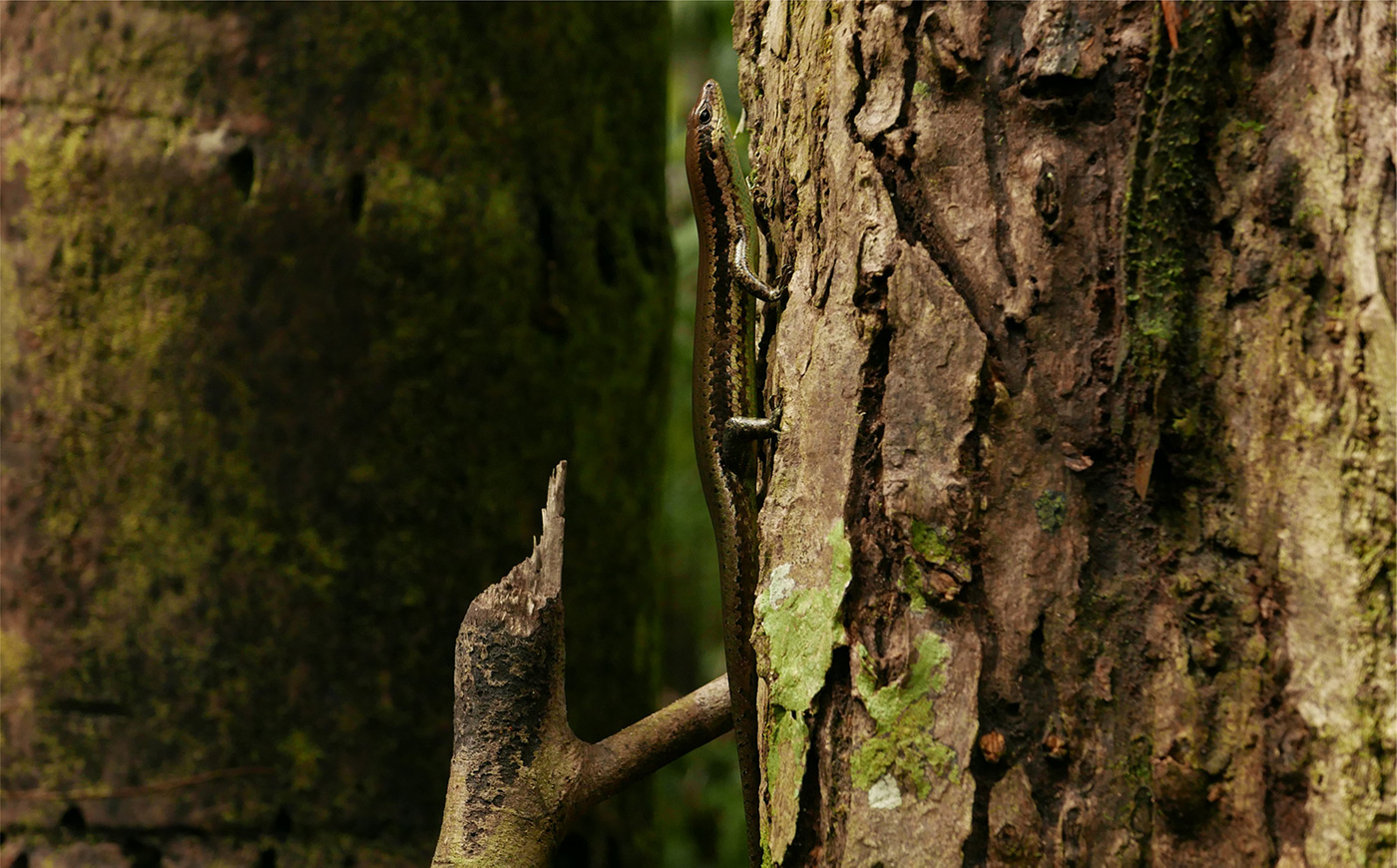
A well-hidden lizard
A close look into the palm swamps reveals more than the trees and plants visible at first glance; here we see a South American Spotted Skink (Copeoglossum nigropunctatum). There is still much to learn about the animals that live in the peatlands, especially those which forest communities do not hunt. Tropical swamps are particularly difficult to survey as keeping quiet while walking on water-logged ground is difficult; using automatic cameras triggered by movement helps to overcome this. Without basic information on the distribution and abundance of wildlife, it is difficult to develop conservation strategies for swamp-dwelling animals.
Photo: Ian Lawson

Mauritia flexuosa
This palm species, known throughout Peru as aguaje, is dominant across large areas of wetland in the Peruvian Amazon. Mauritia palms thrive in the low-nutrient, water-logged ground of peatlands, conditions which many other species cannot tolerate. Under swampy, waterlogged conditions, any organic matter that arrives in the soil from the forest above decomposes only very slowly, and the roots, stems, branches and leaves of Mauritia contribute to the slow build-up of the organic-rich soils known as peat.
Photo: Anna Macphie

Peatland palm swamp (aguajal)
Sprays of leaves from young Mauritia flexuosa palms are visible in the foreground, while mature trunks (with horizontal marks) stretch into the distance. Mauritia dominate this type of peatland forest, the most widespread ecosystem in the Pastaza-Marañón basin. This is one of our study plots, and every stem greater than 10 cm in diameter has been tagged, identified and measured. Measurements are repeated regularly by ecologists to monitor stem growth, recruitment and mortality. Plant diversity in these plots is relatively low, averaging 38 species per 500 stems compared with 166 species per 500 stems in nearby unflooded rainforest.
Photo: Ian Lawson

Breather roots of Mauritia flexuosa
Aerial breather roots (pneumatophores) rise above the surface of standing water in this close-up of the forest floor of a flooded palm swamp. These specialised roots are extensions of the palm’s underground root system, growing vertically upwards to reach above the water level like snorkels. They allow plants like Mauritia to grow in soil that is water-logged or even fully submerged for much of the year. Gas exchange (oxygen in, carbon dioxide out) takes place between the root tips and the atmosphere, allowing the roots to respire and the trees to thrive.
Photo: Ian Lawson

Quistococha Lake
Surrounded by peatland palm swamp, Quistococha is a large body of water 10 km from the city of Iquitos. Many peatlands around the world begin life as a lake; by studying Quistococha we can understand how these important environments form over thousands of years.
In the Amazon basin, rivers meander through the landscape in great looping curves, changing course and leaving behind abandoned channels and stranded lakes. Sediment cores from Quistococha contain sandy river sediment 5m below the lake bed, showing that it was part of a river channel until around 2,500 years ago. Finer sediments record when this part of the river channel was cut off, forming the lake, and fossil pollen in these sediments reveal that Quistococha’s fringing palm swamp began to form 1,000 years ago.
Photo: Katy Roucoux

Open peatland
Scattered Mauritia flexuosa palms in an open peatland close to the community of Veinte de Enero. Fossil pollen preserved in the peat shows that the vegetation at this site has been open — largely made up of sedges, grasses and ferns — ever since peat started to accumulate around 1,200 years ago. The scattered palms seen here are therefore colonising the open peatland, rather than being the last survivors of a once luxuriant forest.
Photo: Lydia Cole

Cecropia, the forest pioneer
The palmate leaves of a Cecropia tree make a distinctive pattern against the sky through a gap in the peatland forest canopy. The genus Cecropia includes several tree species that are ecological pioneers, meaning that they grow quickly in response to a sudden influx of light through the space left by a fallen tree. Birch fills a similar ecological niche in Scotland.
Photo: Katy Roucoux

River bank
White stems of Cecropia are reflected in the mirror-like surface of the slow-flowing water. As ecological pioneers, the fast-growing Cecropia species thrive in the light at the edge of the forest and along unstable riverbanks.
Many species of Cecropia can tolerate with ease the deep floods which come each rainy season to this part of the Amazon. The sharp colour change, from brown to bright white, on each Cecropia trunk marks the height of last season’s flood.
Photo: Lydia Cole

Euterpe precatoria palm
Looking up through the brightly lit branches of a young Euterpe precatoria, one of several palm species common in the peatland palm swamps. Known locally as huasaí or acaí, many parts of this palm are useful. The tall trunks are used for construction, the fruits are made into juice which is rich in antioxidants, and extracts from the roots and leaf stalks have strongly anti-inflammatory properties. In recent years, the fruits have become known internationally as a super-food, marketed as acaí berries.
Photo: Ian Lawson

A well-hidden lizard
A close look into the palm swamps reveals more than the trees and plants visible at first glance; here we see a South American Spotted Skink (Copeoglossum nigropunctatum). There is still much to learn about the animals that live in the peatlands, especially those which forest communities do not hunt. Tropical swamps are particularly difficult to survey as keeping quiet while walking on water-logged ground is difficult; using automatic cameras triggered by movement helps to overcome this. Without basic information on the distribution and abundance of wildlife, it is difficult to develop conservation strategies for swamp-dwelling animals.
Photo: Ian Lawson
Walking through the forest and wading across swamps to reach a sampling site for an ecological survey. Where necessary, a machete is used to cut through troublesome spines and impenetrable vegetation where an alternative route is not possible.




